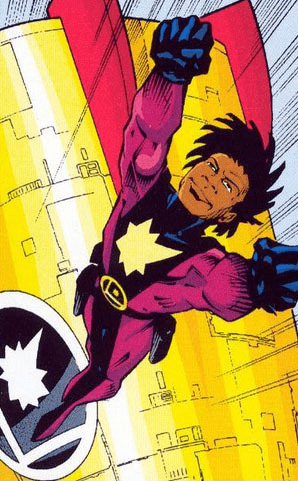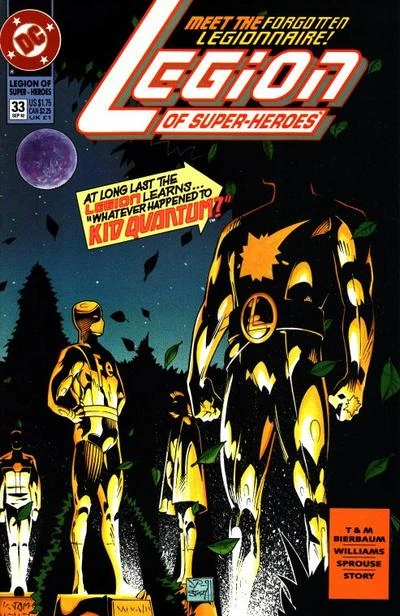
The history of the Legion of Super-Heroes is filled with triumph and tragedy, but few stories are as impactful as that of Kid Quantum. On this day in comics, July 21, 1992, readers were introduced to a hero whose legacy would be defined by sacrifice and the difficult lessons learned from loss. His story is a poignant reminder that in the world of superheroes, great power and great intentions do not always guarantee a happy ending. This particular chapter in the Legion’s saga highlights a darker, more politically charged era for the team from the 30th century.
The story of this ill-fated hero unfolded in the pages of Legion of Super-Heroes Vol. 4 #33, a period in DC Comics history often referred to by fans as the “Five Year Gap.” This era was masterminded by a talented creative team that sought to bring a more mature and complex tone to the futuristic team. They explored a future where the United Planets was crumbling, and the Legion had been disbanded and outlawed. It was into this gritty reality that a new generation of heroes emerged, attempting to rebuild the legendary team. More than just super-powered teens, these were young adults hardened by political turmoil and personal loss, making the introduction and subsequent fate of Kid Quantum all the more resonant.
The Complicated History of Kid Quantum
The legacy of Kid Quantum is unique because it technically belongs to two individuals, both named James Cullen. The first version of the character introduced during this era was a member of the planet Xanthu’s team of heroes, the Uncanny Amazers. He possessed the ability to create stasis fields, effectively freezing time in a localized area. However, his natural abilities were not powerful enough for field use, so he relied on a special device—a “stasis belt”—to amplify and control his powers. When the Legion of Super-Heroes began recruiting again, he was a prime candidate.
Tragically, James Cullen became the first Legionnaire to die in the line of duty during this new incarnation of the team. During a critical mission, his overconfidence got the better of him. He rushed into action, but his power-enhancing belt malfunctioned at the worst possible moment, leading to his swift and shocking death. His demise sent ripples through the re-forming team, a brutal welcome to the realities of their dangerous profession. This event led the Legion to institute a firm new rule: no members would be admitted whose powers were solely dependent on technology. It was a rule born directly from the trauma of losing Kid Quantum, a measure intended to prevent such a tragedy from ever happening again. Fans of the latest comic book covers know that character death is often a major event.
A Legacy Continued, A Lesson Reinforced
Years later, a second James Cullen appeared, revealed to be the sister of the original hero. She was also from the planet Imsk and possessed the same latent time-manipulating abilities. Determined to honor her brother’s memory and prove the worth of their shared power, she developed a new, more stable version of the stasis belt. She eventually petitioned for Legion membership, and despite the rule her brother’s death had inspired, the team made an exception. They recognized her skill, determination, and the advanced safety of her technology. This new Kid Quantum went on to have a long and successful career with the team, serving as a living tribute to the brother she lost. Her presence was a constant reminder of the high stakes involved and the importance of balancing bravery with caution.
This entire saga was part of a bold direction for the Legion, steered by creators who weren’t afraid to explore darker themes. The full creative team on the debut issue, Legion of Super-Heroes #33, included:

- Writers: Tom & Mary Bierbaum
- Penciler: Stuart Immonen
- Inker: Ron Boyd
- Colorist: Tom McCraw
- Letterer: Pat Brosseau
- Editor: Michael Eury
Their work grounded the futuristic fantasy of the Legion in a world that felt dangerous and unpredictable. While many new comics explore complex themes, the “Five Year Gap” Legion was a trailblazer in its time. The intricate plotting and character-driven drama from this period remain a fan-favorite era for many longtime readers of DC Comics. The journey of these characters is a core part of what makes the Legion such an enduring comic book concept. For a team composed of dozens of heroes, creating a legacy that stands out is a remarkable feat, and the story of Kid Quantum certainly does. His influence extends far beyond his brief, tragic appearance, shaping the very laws of the institution he died serving. It’s a powerful narrative about how organizations and individuals grow from their failures. The entire comic book addicts community often reflects on these pivotal moments in comic history.
In conclusion, the story of Kid Quantum is a cornerstone of the Legion of Super-Heroes’ modern mythology. It represents a turning point for the team, forcing them to confront the deadly consequences of their work and establish new protocols to protect their members. The tragic death of the first James Cullen and the determined legacy of his sister provide a rich, emotional narrative that continues to resonate with readers decades later.
What did you think of this issue? Join the conversation on X and tag us @comicbookaddt!
Follow us on our other social networks:



